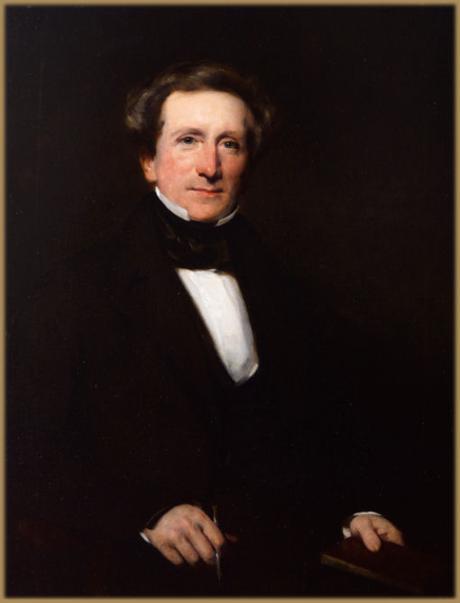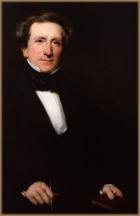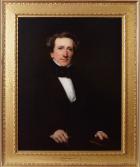Warren, Samuel (1807–1877), lawyer and writer, was born on 23 May 1807 near Wrexham, Denbighshire, the elder son of Dr Samuel Warren (1781–1862), clergyman, and his first wife, Anne (1778–1823), daughter of Richard and Elizabeth Williams. Little is known about Samuel Warren's early education except his statement in the preface to Passages from the Diary of a Late Physician that he was for six years before 1827 'actively engaged in the practical study of physic' (Preface to fifth edition, edn of 1837 Passages in Warren, Works, 1854–5, vol. 1), perhaps as an apothecary's apprentice. From 1826 to 1828 Warren attended the University of Edinburgh where he studied various subjects and won prizes in comparative jurisprudence and poetry, but did not obtain a degree. His poetry prize led to introductions to Christopher North (John Wilson), and to Thomas De Quincey, two of the leading lights in Blackwood's Magazine.
Warren was admitted to the Inner Temple, London, in 1828; he studied law and worked as a special pleader there until 1837, when he was called to the bar. In 1831 he had married Eliza Ballinger (c.1802–1868); they had two sons and a daughter. This period also saw the serialization in Blackwood's Magazine of the work that made his literary reputation, Passages from the Diary of a Late Physician (1831–7). He later described his views and feelings in writing the book as 'those not of a Novelist, but of a Moralist' whose 'steady purpose … was to exhibit deathbeds' (Preface, 1854 edn of Passages in Warren, Works, 1854–5, vol. 1). The success of the book depended on the sensational and melodramatic atmosphere of the stories which parade the horrors of debauchery, disease, madness, and death with an almost erotic fascination.
Warren had not restricted his writing to creative efforts during this time; he also published the first edition of A Popular Introduction to Law Studies (1835), a guide for those intending to become law students. In 1837 Warren, with John William Smith, published Select Extracts from Blackstone's Commentaries, and he was later to publish a much extended Blackstone's in 1855 and 1856.
Warren's second novel, published in Blackwood's Magazine from 1839 to 1841, was Ten Thousand a-Year. The novel, which was an immediate best-seller, concerns a firm of attorneys who discover that Tittlebat Titmouse, a poor draper's clerk, may have a claim to the large estate of Yatton. The attorneys commence an action which results in Titmouse displacing the unbelievably pious John Aubrey as the owner of the estate, and its annual income of £10,000. Titmouse revels in his new found wealth, until a new round of litigation is commenced which returns Aubrey to his place as squire of Yatton. Titmouse is disgraced, and ends his life in a lunatic asylum. The narrator repeatedly tells the reader that the English legal system is close to perfection, but the actual workings of the law in Ten Thousand a-Year paint a more negative picture.
Dickens seems to have read Warren's fiction and non-fiction, and to have borrowed images and ideas. Sir Leicester Dedlock and the solicitor Vholes in Bleak House (1852–3) resemble the earl of Dreddlington and Gammon, Titmouse's principal lawyer, in Ten Thousand a-Year. The striking picture of barristers in court bobbing up and down like hammers in a pianoforte in the first chapter of Bleak House is similar to an image in chapter nine of the second edition of A Popular Introduction to Law Studies (1845). Wemmick's habit of collecting mementos from Jaggers's criminal clients in Great Expectations parallels Quirk's practice in Ten Thousand a-Year. Warren may have returned the favour by using elements of the Bardell v. Pickwick case in Ten Thousand a-Year.
Warren's third novel, Now and then (1847), tells the story of Adam Ayliffe who is convicted unjustly of murder, although his death sentence is commuted to transportation. The novel leaps forward twenty years to reveal that Adam was innocent of the murder, and we are told by the parish priest, a character apparently incapable of irony, that the wrongful conviction resulted from 'the unavoidably imperfect administration of justice' (ch. 18). Much of the novel is taken up with the struggle by the priest to convince the victim's father, the proud and vengeful earl of Milverstoke, that he should show Christian mercy and forgiveness to Ayliffe. The earl (and the reader) eventually gets the point. The broader religious goal of the novel is to justify God's ways to humanity, but Warren relies on assertion and sermonizing to urge the reader to faith.
In 1848 Warren published a series of four lectures, originally given to students and young attorneys at the Law Society, as The Moral, Social, and Professional Duties of Attorneys and Solicitors (1848). The book is a mixture of ethical advice, tips on practising law, and assurances that attorneys can, with effort, learn how to behave like gentlemen. Warren assures his audience that attorneys are not inferior to barristers, although he is less egalitarian elsewhere. Other legal publications included the second and third editions of Law Studies (1845, 1863) and two books on election law (1852, 1853). Warren continued to practise law until the mid-1850s and became a queen's counsel in 1851, but found it difficult to attract business. He achieved some success within the Inner Temple where he was elected as a bencher in 1851.
Warren continued to explore philosophical and religious issues in his creative work, especially in The Lily and the Bee: an Apologue of the Crystal Palace of 1851 (1851), The Intellectual and Moral Development of the Present Age (1853), and 'Speculators among the stars' (1854). These texts are interesting as a catalogue of one religious Victorian's terrified vision of a world without Christianity: dark, amoral, determinist, animalistic, despairing, sinful, a charnel house of decayed and decaying opinions, a 'mental and moral shipwreck' (Intellectual and Moral Development).
William Blackwood & Sons published Miscellanies: Critical, Imaginative, and Juridical in 1854, and a collected Works in five volumes in 1854 and 1855. Warren's political fidelity, as well as his writing, were recognized when he was in 1853 made an honorary DCL of the University of Oxford, with Bulwer-Lytton and others, on the occasion of Lord Derby's installation as chancellor of the university. His Conservative political sentiments led him to support the policies of Peel and later Lord Derby in a series of books and articles. In 1856 Warren was elected to the House of Commons for the borough of Midhurst (Sussex). He held the seat until 1859 when he was appointed a master in lunacy 'at a munificent £2,000 a year stipend' (Sutherland, 660). The Lunatics Acts of the mid-nineteenth century empowered the masters in lunacy to make decisions about persons of unsound mind, including the management of their property. Most contemporary observers praised Warren's handling of the mastership. Warren became reader at the Inner Temple in 1865, and treasurer in 1866. He also held the judicial post of recorder of Hull from 1852 to 1874.
Warren's first marriage had been happy, and he was deeply affected by the loss of his wife on 29 August 1868. Some three years later, on 23 August 1871, he married Louisa Beaumont. Warren died on 29 July 1877 at his home at 16 Manchester Square, London. He was survived by his second wife, and was buried on 3 August 1877 at Christ Church, Esher, Surrey, where his son was rector.
C. R. B. Dunlop DNB.
Sir John Watson Gordon, (1788–1864), painter of historical subjects and portraits, was born in Edinburgh. He was descended from the Watsons of Overmains, Berwickshire, and he was the son of Captain James Watson of the Royal Artillery. John Watson trained to follow his father into the army, but before receiving his commission took drawing lessons with John Graham at the Trustees' Academy in Edinburgh and studied with his uncle George Watson, who was the first president of the Scottish Academy, and also with Sir Henry Raeburn, who was a family friend, and decided instead to become a painter. In order to distinguish himself from his cousin and his uncle who were both artists, he later assumed the name Watson-Gordon and appears as such for the first time in the catalogue of the 1826 exhibition of the Royal Institution, Edinburgh, of which he was an associate.
Watson-Gordon is today best remembered—and is still highly regarded—as a portrait painter, but his earliest works were genre scenes. His diploma picture, A Grandfather's Lesson, depicted his father tutoring a fair-haired girl. Like many works of the time it suffered from bituminous cracking caused by the addition of tar into the blacks to enrich their lustrous effect. The stiff figures in another work, The Laird of Cockpen(McManus Galleries, Dundee), an interpretation of a well-known Scottish song, reveals the clumsy draughtsmanship of his earliest period. Another early work, however, a portrait of the songwriter Carolina Oliphant, Baroness Nairne and her Son William Murray Nairne (Scot. NPG) shows more skill. The lace edging to the sitter's cap and plum dress, her shining curls, and gentle expression are all expertly captured, although the physical grouping of mother and son is not entirely resolved. In 1808 Watson-Gordon exhibited a scene from Sir Walter Scott's Lay of the Last Minstrel at the first public exhibition held in Edinburgh; then, the following year, The Battle of Bannockburn and Queen Mary Forced to Abdicate the Crown. He continued to paint historical and religious subjects but after 1821 turned to portraiture and when Raeburn died in 1823, Gordon became the leading portraitist in Scotland. Like his uncle, in portraiture Watson-Gordon was greatly influenced by Raeburn's painting style. Thomas Clerk and his Wife (1820; Royal Company of Archers, Edinburgh), for example, shows clear similarities, in both composition and treatment, with Raeburn's Sir John and Lady Clerk of Penicuik (1792; NG Ire.), although this early work by Watson-Gordon lacks the atmosphere and bravura of Raeburn'sdouble portrait. Watson-Gordon was a founding member of the Royal Scottish Academy in 1826, and was represented in the academy's annual exhibitions from 1830 until 1865. He also exhibited at the Royal Academy in London from 1827, becoming an associate member in 1841 and a full member ten years later. As a result his work became well known in England and many English people travelled to sit for him in his Edinburgh studio. Among them was the landscape artist David Cox, whose friends in Birmingham commissioned a three-quarter-length portrait of Cox from Watson-Gordon (Scot. NPG). Cox was reportedly delighted with the portrait and enjoyed the sittings in Edinburgh—he described Watson-Gordon as 'affable and entertaining, with a grave and dignified carriage' (Solly, 238). Watson-Gordon's portraits were both popular and critically acclaimed. With limited use of colour, dramatic lighting, and by focusing attention on the face, he managed to convey a heightened impression of the character of his sitters. He was especially successful when portraying the intellectuals of his day and painted most of the Scottish celebrities and writers of his time, including Lord Cockburn, James Hogg (in a rugged and romantic depiction The Ettrick Shepherd, swathed in plaid) (both Scot. NPG), and Sir Walter Scott (four portraits including an unfinished study of 1830, Scot. NPG), whom he painted many times. Scott was first portrayed by Watson-Gordon in 1820. He also commissioned from the artist a set of family miniatures for the travelling writing-case of his son Walter, who was in the army. Watson-Gordon was at his best when depicting older men. He managed to convey the shrewdness and wisdom of their years in apparently spontaneous, somewhat informal paintings, such as his portrait of Professor John Wilson of 1822; Raeburn had also painted Wilson, as a dashing young man wearing riding habit and standing next to a powerful horse (both paintings Scot. NPG). Watson-Gordon revealed the rugged features of his 68-year-old sitter in a less gallant but no less dramatic painting than that of Raeburn, painted several decades before. He was far more successful when doing this than when attempting to capture the essence of a youthful or female sitter, for example Mrs George Baird of Strichen (Tate collection).
Watson-Gordon's portraits of the earl of Dalhousie (1833; Archers' Hall, Edinburgh) and Lord President Hope (1832; Signet Library, Edinburgh) are important examples of the full lengths of his middle period, when his works were rich and varied in colour. In the latter the lord president is depicted in ermine robes standing before the colonnaded façade of Parliament House. His portraits Dr. Brunton and Principal Lee (Edinburgh University) indicate a change of style, which illustrates clearly the influence of photography on Watson-Gordon during the 1840s and 1850s.
In March 1850 Watson-Gordon was elected to succeed Sir William Allan as president of the Royal Scottish Academy. Shortly afterwards he was knighted and appointed royal limner for Scotland. In 1855 Watson-Gordon achieved international acclaim when he was awarded a gold medal at the Paris Universal Exhibition for his intimate and intense portrait of Roderick Gray, provost of Peterhead (1852; Merchants' Hall, Edinburgh). This painting, one of his finest, is characterized by its simplicity of composition and limited palette, the draperies and accessories being subordinated to the head, which is handled with great freedom, yet high finish, and on which is concentrated the main light and warmth of the picture. Many of his portraits were engraved, Edward Burton'smezzotint after the portrait of Roderick Gray being one of the most noteworthy.
In 1860 volunteer forces were springing up all over the country in reaction to increasing militarism throughout Europe. Watson-Gordon enrolled in no. 1 City artillery, which had sixty-four soldiers, many of whom were members of the Royal Scottish Academy. He donated £20 to the cause, in addition to the £5 subscription. Watson-Gordon died at Catherine Bank, Trinity, Edinburgh, on 1 June 1864. In his memory his brother and sister endowed the Watson-Gordon professorship of fine art, which was instituted at Edinburgh University in 1879 and was the first chair in art history in Britain.
- Jennifer Melville DNB



